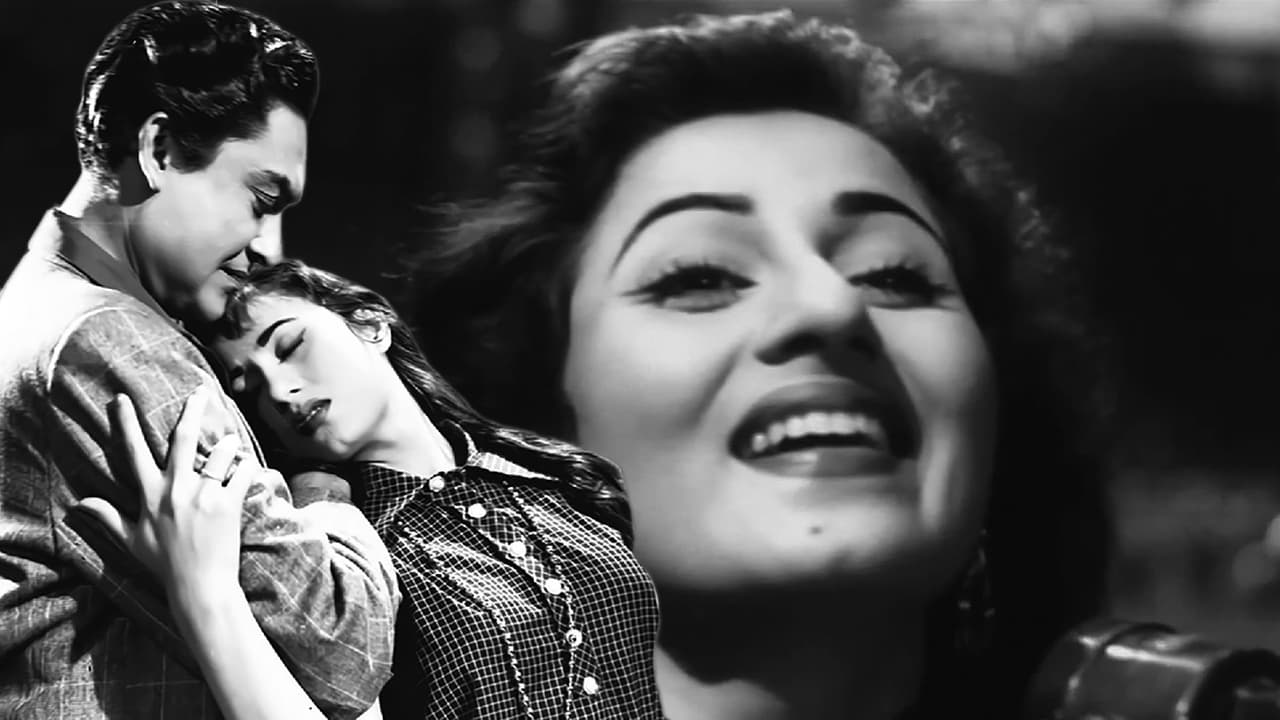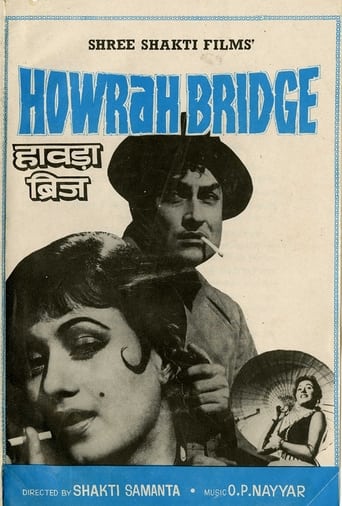Exoticalot
People are voting emotionally.
KnotStronger
This is a must-see and one of the best documentaries - and films - of this year.
Stephan Hammond
It is an exhilarating, distressing, funny and profound film, with one of the more memorable film scores in years,
Lachlan Coulson
This is a gorgeous movie made by a gorgeous spirit.
pvsavla
saw this film for its antique value, being passionate about Bollywood movies. As boxofficeindia.com rightly depicts the status of this film amongst all those released in 1958 as 'Above average' because this picture is worth watching only for its two popular songs, story and Howrah bridge in that order. This was the first film of Shakti Samant as producer and a good one to begin with. Although Ashok Kumar and Madhubala were very popular for those times, but they did not seemed to be an extra ordinary pair, as Ashok Kumar, appeared slightly above age as the main hero against the young Madhubala, irrespective of the same, one did not mind seeing them together for their acting. Anyone who has time and has made it a point to see all the Top 10 popular films of a particular year, then it is worth it. Overall it is not going to disappoint to see this film.
sashashyam-1
HOWRAH BRIDGE (1958) Contains spoilers.Watching Howrah Bridge for the first time in 52 years - I saw it last, at 11, at its theatrical release in 1958 - I was struck by the unexpected chemistry between Ashok Kumar, normally no great hand at love scenes, and Madhubala. Whether on board the ship, in the restaurant of her uncle's hotel, or during the boat ride and the coach ride, the vibes between the two are amazing, especially when one remembers their stilted scenes together in Mahal. One presumes the credit for this should go to the director, Shakti Samanta, something of an expert on screen romance , who has infused it even into a wannabe noir film like Howrah Bridge.Madhubala is at her most beautiful here, luscious, radiant and unaffectedly gorgeous. Vibrantly alive,she lights up every scene she is in, and it would be hard to find a single shot in which she is at a disadvantage, despite, or perhaps because of the simple outfits and minimal make-up. It was uncommon in those days for the heroine in a Hindi film to be an Anglo-Indian, but Madhubala's Edna was probably to reconcile her being the heroine with her singing and dancing in a hotel restaurant, as Anglo-Indian women were, in those days, considered to be more westernized.The spontaneous affection for Ashok Kumar, mercifully free of coquetry, that Madhubala projects throughout - especially in the boat scene and during their ride in the coach - is a delight to watch, as is the smiling admiration and tenderness, plus a sense of belonging together, that Ashok Kumar brings to these scenes. Having watched him in many films as a leading man, I have never before seen him play the lover so convincingly, or to smile with such unforced cheerfulness.The film is today remembered mostly for Helen's item number (to use the current Bollywood lingo) Mera Naam Chin Chin Choo, which is still played at wedding processions on the streets of India, but OP Nayyar's musical score here has all of the lilt and the sensual, languorous appeal that set him apart for over a decade, and then some. Rewatching the film after so long, I felt fresh delight as one number after another, familiar and beloved but of long forgotten origin, surfaced, and I ended up rather like the reader who remarked that "Shakespeare is full of quotations"! Nayyar has a tendency to reuse his signature flourishes, the opening music of the title song of Phir Wohi Dil Laya Hoon, that appears suddenly here as well, was obviously created first for the earlier Howrah Bridge.There are no diversions of the family kind in this film, and no emotional tangles, and the neon lit ambiance of the streets and the dim lit interiors keep the mood of the film intact. The club dances are a far cry from the huge affairs with 100 extras that populated the Bollywood films of the 1970s-90s, the supporting dancers are limited to a realistic number, and the orchestras are small and muted, allowing the voices to stand out and soar. Madhubala was no dancer, but the dance director manages to camouflage this by keeping her movements simple and seductive but not demanding. Helen went on to far more daring outfits and daring dance moves – in later years her item numbers, most often with the leading man, were a major USP for those films - but the simple charm of Mera Naam Chin Chin Choo is hard to beat.For the benefit of Virgina_NYC, the storyline is fairly linear and hold together well, with no obvious plot holes. The so-called Chinese-origin "dragon", which is fact only a dragon face, almost like a mask, is stolen from Madan, the thieving elder brother of the Rangoon-based Prem Kumar (Ashok Kumar), by Pyarelal (KN Singh), the partner of John Chang, to whom Madan tries to sell it. Madan is murdered by Pyarelal and his goons and dumped in Howrah Bridge. Prem Kumar comes from Rangoon to Calcutta to try and finds his brother's killer and retrieve the "dragon".Edna (Madhubala), is a club dancer he meets on the ship and again at her uncle's hotel, whom he cultivates in the hope that she might provide useful information. However, she makes it clear to him from fairly early on – during the boat ride - that she hates the goings on into which she is forced by her uncle and his associate Pyarelal. So there is no ambiguity as to which side she is on.Prem Kumar has a duplicate "dragon" made and, in disguise as an Arab sheik, offers it to John Chang and tries to convince him that the one that was stolen from Madan was a fake. Prem Kumar probably plans to switch the two while negotiating the sale, but it all comes to nothing as he has to flee prematurely. The duplicate 'dragon' has no other role to play in the story. The complications created by the excessive greed of the sole witness to the murder, and by Prem Kumar's habit of dropping his personal possessions – first his wallet on the ship, and then his cigarette case in Chang's hidden chamber – keep the story ticking along smoothly. The police are conscientious if not excessively smart, and for once do manage to turn up in time and actually shoot the villain dead, a welcome variation on the theme of the all conquering hero, and much more realistic.One last word, or rather two: Hindi film heroes used to smoke an awful lot in those days, but it is completely out of fashion now. And Madhubala, en route to domesticity in Rangoon, has changed from her western outfits into a Saree, the proper dress for a proper Indian wife and daughter in law. It is another matter that there is just no dress as elegant and graceful as the Saree.
VirginiaK_NYC
This isn't the first movie of Helen, but her entrance here, at about age 19, feels like a triumphant introduction - slim as a reed, with a young girl's face made up lightly, just to emphasize the tilt of her eyes, she glides down a staircase in a Chinese costume to perform Meera Naam Chin Chin Chu, an all-time great Hindi cinema song. I think the movie is worth owning for this and for Madhubala in an Ava Gardner-like incarnation, singing and dancing in full-skirted lush western dresses.An unusual film to me -- it seems to be a Bollywood effort at a noir-style mystery story. I'd say the "noir" element is present in the milieu and the cinematography more than in the story itself. The world of the story is a world of seedy small hotels and nightclubs in Calcutta. Most of the main dramatic scenes are interiors of these places at night, and people are always moving in and out of light that casts various shadows on their faces.A dramatic chase scene makes great use of the Howrah Bridge, an imposing Erector-Set structure that is a Calcutta landmark.There's also a style of Indian Orientalism here, as well I think as a use of some motifs from LA noir of this time period - there is a Chinese villain, played well by an Indian actor (i.e. not the random bowing slant-eyed stereotype we run into here and there in other movies) and the first part of the story takes place in Rangoon, its characters' home - so there are many references to "oriental exotic" outside of India.Not unusually and not surprisingly, the story lacks the things that make noir noir - we've got our stereotypes moving around, doing things and reacting to things, and we don't have any of the moral ambiguity of the American film noir, where a hero without conventional social moorings has his own ethics, and a woman probably will not turn out to be who she seems to be. We do, though, have wonderful 50s western costumes on the primary characters, as well as Indian-style masala characters who sing, dance, and have a wedding which Madhubala stops to watch when she is pursuing someone.The story also sticks mostly to the characters involved in the mystery - Ashok Kumar, Madhubala, a Tonga-wallah who is Ashok's guide into the more mysterious parts of Calcutta; the Chinese art dealer, and the man named Joe who owns a hotel and makes claims on owning Madhubala too. There is also the opium-smoker who witnessed the murder, and his lovely fiancé. But there are no extra relatives bringing in "emotion," which, for India, does stick to the noir mystery format and to the single plot line to an exceptional degree.The basic story: Ashok Kumar, in Rangoon, learns that his brother has apparently stolen the precious family heirloom dragon statuette, and soon thereafter learns the brother has been killed in the course of his effort to sell it, so he travels to Calcutta to try to reclaim the thing and solve the mystery.Along the way he meets Madhubala, who sings and dances in a hotel. At an early point I think we were meant to wonder whose side she was on, beyond that, the plot lost me somewhat, and I also don't think it was totally coherent but may be wrong. If someone else watches the whole thing, I'd like to know if you think the existence of the duplicate Family Heirloom really had anything to do with anything that happened.Anyhow enjoy it for its eight songs, Helen (in just the one), and Madhubala.
vinod-2
If you're a old hindi movie fan its a must see.The plot might have been original for those days, by today you've probably seen a hundred movies along the same story line. But the choreography is worth watching. If you're a music fan there are some good songs including the infamous "Mera Naam Chin Chin Chu".

